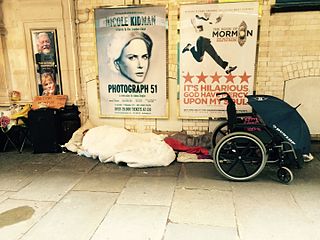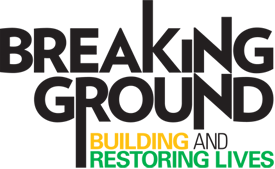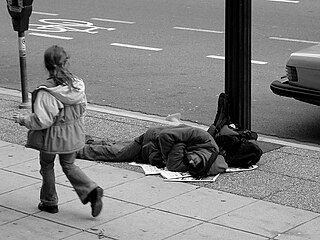Background
London, as the UK's capital city, has always attracted large numbers of migrants unable to find affordable housing. Other large towns and cities had similar populations of homeless people and some sleeping rough but on a much smaller scale.
Many had severe and enduring mental health problems like Schizophrenia, which made them 'homeless and rootless' or meant they had no settled way of life. [1] Others had impoverished or no social support from family or friends. Some had left institutions like the army, prison, care homes or psychiatric hospitals.
These migrants slept in places that were mainly hidden from public view. Lincoln's Inn Fields was one site, the arches under Waterloo Bridge and the area behind the Royal Festival Hall were others. The most famous was the area covered by Hungerford Bridge by Embankment Station, where charity 'soup runs' handed out food and blankets, medical assistance and other forms of social support including offers of a bed for the night - a 'kip'.
Gradually during the 1980s a number of factors combined to turn what had been a background issue into a social and political crisis.
Rising property values turned run-down Victorian terraced family housing, whose owners had been making ends meet by renting rooms to low-skilled migrant labourers, into marketable assets. These lodgings or 'digs' were often run by women 'landladies', who provided some social support as well as basic lodgings and meals for an affordable rent. These were sold off through this period leaving their one-time residents homeless.
A slowdown in the merchant shipping and docks in the Port of London led to a layoff of men who were mobile and had been well paid but in idleness had nowhere to go and found work hard to come by
Changes in government policy designed to improve the accommodation standards for hostel dwellers closed an estimated 5,000 places in London hostels. This loss of basic shelter put the numbers of people sleeping rough into the thousands on the streets of the UK capital.
There was a view that 'Care in the Community' had led to psychiatric hospital patients being turned out into the streets. Though this was never substantiated many ex-patients did suffer neglect and abuse once released.
News coverage of the rising street population became a part of the mood music to the Tory government's unravelling social and economic policy agenda.
St Mungo's and National Sleep Out Week
In 1989 St Mungo's, a homelessness charity, organised National Sleep Out Week to highlight the problem and give a focus to the mood of concern. The second such event in 1990 was discussed in Parliament and recorded in Hansard (view here). Coverage was repeated in 1991 and the diminishing popularity of Mrs Thatcher's premiership was highlighted by the 30,000 people said to have slept out to raise awareness and funds to help homeless people.
Mrs Thatcher's fall from grace with her parliamentary party is dated to a speech by her Deputy Prime Minister Geoffrey Howe, whose wife Elspeth took a leading role in publicising the homelessness campaign and is widely credited with writing the speech that her husband delivered in Parliament leading to his boss's political demise.
In 1993, Michael Leapman wrote in the Independent, [2]
"She has also been an active campaigner against homelessness. In June 1990 she was one of several prominent people who spent the night in a cardboard box to highlight the problem.
"Sir Geoffrey was then still a member of the Cabinet and Margaret Thatcher, the prime minister, was furious at Lady Howe's gesture. It helped to widen the rift that led first to Sir Geoffrey's resignation (it was said that Lady Howe wrote his speech) and thence to Mrs Thatcher's removal from office."
Once Mrs Thatcher had gone, Sir George Young bt, a Tory 'wet' with a long-standing interest in homelessness and a solid reputation amongst campaigners, was appointed housing minister with 200 million GBP to spend on getting people off the streets.
The level of street homelessness (rough sleeping) has declined steadily in England since the late 1980s following a number of successful government-funded programmes introduced from 1990 onwards by both Conservative and Labour governments.
These initiatives are often referred to as the Rough Sleepers Initiative (RSI). In fact, the three phases of the RSI lasted from 1990 until 1999. Until 1997 the RSI was concentrated on London where the number of rough sleepers was far higher than in any other part of the country. In 1997 the RSI was extended to 36 other areas of England. In 1999, following the publication of a government report ‘Coming in from the Cold’, the RSI was replaced by a new programme, overseen by the RSU, which had been created in the previous year following the election of a Labour government.
The RSI commenced in 1990 as a result of a continuous rise in rough sleeping during much of the 1980s, notably in central London where the number of rough sleepers was particularly high and visible, and therefore political sensitivity around the numbers, especially pronounced.
During the 1980s a number of large encampments of rough sleepers grew up in various places, usually referred to by the media as 'Cardboard City'. In fact Cardboard City was in a sense a mobile city. In the early 1980s it existed close to the River Thames at the London Embankment tube station and was closed as a rough sleepers site by Westminster City Council working with the voluntary sector so that the space used by rough sleepers could be upgraded into a retail shopping area. Many rough sleepers were assisted to find permanent accommodation (self-contained council and housing association flats) through the resettlement work that was undertaken prior to the site being closed.
Cardboard City then relocated to Lincoln's Inn Fields, a central London park, where a similar closure operation took place in the late 1980s, and then onto a site in South London, ‘the Bullring’, where a third closure operation took place in the early 1990s. On each occasion some parts of the voluntary sector engaged with the relevant local authority to support the clearance of rough sleepers from the area. The justification for doing this was not only the inevitability of the closure but also the offer of additional help for the rough sleepers affected, including access to permanent accommodation and extra help to address other support needs associated with poor mental and physical health and substance misuse.
Some organisations opted to not be part of this partnership on the grounds that for rough sleepers it was an infringement of their liberty and would lead to rough sleepers being displaced elsewhere. Indeed, the evidence showed that some people did not take up the offer of help and moved to sleep at a different site. However, others were successfully housed and were able to maintain their accommodation, with support.
By the late 1980s in London approximately 1,000 men and women could be found sleeping on the streets of central London on any one night, mostly in the central London boroughs of Westminster, Camden and Lambeth. The increase in rough sleeping arose for a variety of reasons including:
- A reduction in the number of hostel (shelter) bed-spaces in London as a result of hostels being up-graded from dormitory accommodation into single room accommodation, leading to higher quality hostels but with fewer bed-spaces.
- Reductions in benefit levels and related restrictions affecting people under 25, leading to an increase in rough sleeping among this age group.
- An increase in levels of unemployment in the UK, inevitably decreasing the ability of people on low incomes to maintain accommodation.
- A reduction in the number of social housing units being built and a loss of social housing units as people took up the ‘right to buy’ their local authority council accommodation through an initiative introduced by the Conservative government.
The three phases of the RSI ran from 1990 until 1999 costing the government in total over £200 million. Running concurrently in the early phase was a connected initiative called the Homeless Mentally Ill Initiative (HMII) which arose from public concern about the danger posed by rough sleepers with mental health problems both to the public and to themselves. The HMII was modest in size compared to the RSI but led to the creation of a range of high quality temporary and permanent self-contained accommodation for rough sleepers with mental health problems and included the funding of linked mental health teams to support and complement the work of the generic housing teams providing residential support.
The RSI concentrated on funding:
- The building of almost 4,000 units of accommodation (mostly self-contained, some shared) for rough sleepers across London with the majority of units constructed in south London where land is cheaper.
- Resettlement teams tasked with referring appropriate rough sleepers into the RSI accommodation and supporting them so that they could maintain the accommodation.
- Street outreach teams such as those run by Thames Reach St Mungo's and Broadway making the initial contact with rough sleepers.
- Basic emergency winter shelters in temporary buildings.
- Spaces for rough sleepers in hostels.
The initiative was essentially a partnership between central and local government and the voluntary sector. Additionally, housing associations, health care providers, the police and local businesses were also engaged within what became labelled a multi-agency approach. This was reflected at government level in the creation of an inter-departmental ministerial group to draw together different government departments with responsibilities for people sleeping rough.
The voluntary sector organisations were funded directly by government to provide services. Central government took the unusual step of funding directly as it had little confidence in local authorities to address the problem of rough sleeping. Furthermore, in London the Margaret Thatcher administration of the 1980s had dissolved the Greater London Council and there was therefore no regional body in the capital in a position to take on funding responsibility.
The delivery structure model was based around a number of local consortia that did not take account of local authority boundaries but were instead constructed around the main rough sleeping areas in central London. The consortia were extremely inclusive and as such, often unwieldy due to the size of the membership which included representatives from the voluntary, local government, central government and business sectors.
The RSI, through its various phases succeeded in the following areas:
- It successfully brought together key players around a focused task of reducing rough sleeping.
- Although there were delays in the building of new accommodation for rough sleepers, eventually almost 4,000 units of mostly self-contained accommodation was built with the intention of being for rough sleepers ‘in perpetuity’.
- Resettlement teams ensured that rough sleepers were not only found accommodation, but helped to maintain their tenancy, with some success.
- Outreach teams working in central London provided a greater presence than ever before and developed a process for ‘gate-keeping’ access to the rough sleepers units to avoid them being filled by people who had not slept rough who invariably have lower needs.
- Most importantly, the number of rough sleepers to be found on London's streets on any one night fell from around 1,000 to 270 by 1995.
The limitations of the RSI were that:
- Although numbers fell, by the mid-1990s a plateau seemed to have been reached and although rough sleepers continued to be helped off the street, new rough sleepers took their place.
- Resettlement support offered from the teams was short-term, often for only six months, and as a result statistics showed that almost 20% of people helped into self-contained accommodation left within one-year, often to returning to the street.
- The ‘gate-keeping’ of accommodation by the voluntary sector organisations was very mixed with some agencies undertaking it with greater diligence than others. Spot checks on the self-contained accommodation meant exclusively for rough sleepers exposed that a significant minority of people referred to rough sleeper accommodation had, in fact, never slept rough.










